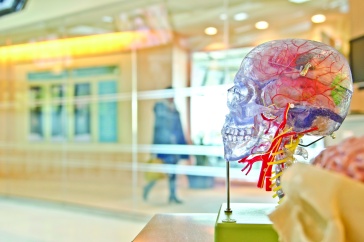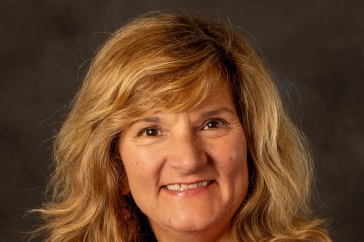The COVID pandemic provided no shortage of opportunities for organizations to adapt, and that’s precisely what four UNH Manchester STEM Teaching Fellows did when they developed outreach activities for second graders at Manchester’s Boys and Girls Club during the fall 2020 semester.
Associate Professor of Biology and Biotechnology Patricia Halpin has been performing and studying science outreach in the New Hampshire area and beyond for over 20 years, but the 2020 teaching fellows were presented with a unique challenge—how to deliver fun educational activities to elementary school-age students remotely.
“There’s no reason to wait until the pandemic is over,” Halpin said. “You can still do outreach successfully. Why allow these children to lose out on this opportunity?”
Four biological sciences and biotechnology students—Jonathan Belmont, Catherine Aborn, Lejla Hodzic and Mamady Sankoh—volunteered to participate in this iteration of the program. They met every week to design their own educational activities and coordinated with Boys and Girls Club STEM director Keith Darling who provided the necessary supplies and materials. Every week the fellows performed a dry run of their presentation and received feedback from their peers, tweaking and changing different aspects until they were ready to make their final presentations. Presentation topics included the function of the brain, the respiratory and digestive systems and the heart.
“Everyone needs to know more about how their body works,” Halpin said, stressing that national, as well as local, science literacy is quite low. “The fellows created engaging activities which enabled them to explain the physiological concepts they were teaching to young children. We really need scientists to focus on and enhance their communication skills in order to educate all audiences. That’s important.”
The teaching fellows also had the opportunity to share their activities with more than just the students. All four fellows submitted abstracts that were accepted by the American Physiological Society and presented at the remote Experimental Biology Meeting in April 2021.
“Unfortunately it wasn’t face to face, but it's still a huge meeting,” Halpin said. “It’s an amazing opportunity for undergraduates to present at one of the largest biological science meetings in the world.”
The fellows were provided with an additional scholarship credit as their abstracts were published in the FASEB Journal.
This year was also the first time the fellowship was paid, thanks to a UNH Collaborative Research Excellence (CoRE) Initiative grant secured by Computer Science Professor Mihaela Sabin.
Interested in learning more about the STEM Teaching Fellows creative and innovative teaching plans? Find their abstracts below.
Providing an immersive learning experience about science is beneficial to students at a young age. The STEM Teaching Fellows program was developed to provide the opportunity for undergraduates to teach K-12 students how the human body functions, and to increase the K-12 students’ interest in learning more about physiology. Four STEM Teaching Fellows worked together to develop weekly classes to be delivered via Zoom to the Boys and Girls Club in Manchester NH. Twelve first-grade students along with the STEM Director were present in the STEM Lab at the Boys and Girls Club while the Fellows participated from campus or home. Using the peer-to-peer learning method each Fellow developed their own lesson plan and then shared it with the other Fellows to prepare them to teach this material to the first-grade students. The preparation session was held one week prior to the lesson session. The second lesson of this program focused on the human brain. This lesson included anatomy using the human skull and brain model, and interactive activities to engage the students and get them interested in the material. One of the activities for the lesson involved having the students identify different functions of the brain associated with the different regions of the brain. After this activity, students were asked questions by the Fellow relating to the material that had been taught, and they were able to answer many of the questions correctly. The students were then encouraged to ask any questions they had about the brain and the material being taught. The class concluded with emphasizing the importance of personal health to promote brain health and function. The first-grade students were assigned homework to continue the lesson after the class concluded by sharing what they learned with family and friends. The STEM Teaching Fellows program was shown to be effective at engaging the students in topics relating to physiology.
It is important to keep children excited and interested in scientific learning and discovery, and that has become an even more challenging task in the age of COVID-19, when most learning is done remotely through Zoom. As part of the STEM Teaching Fellow program, a lesson was created to teach 1st graders at the STEM Lab in the Boys and Girls Club via Zoom about the human respiratory system. At the beginning of the lesson a short PowerPoint presentation provided an overview of the system. Included in the introductory section of the lesson were two short (< 2 min), relevant YouTube videos. Together with the Boys and Girls Club STEM director who was on-site the students were directed through some hands-on activities followed by a discussion of how to keep their respiratory systems healthy. In order to illustrate the concept of gas exchange to the students, they participated in a Gas Exchange Relay race where students were split into 3 different groups, one representing the lungs, one representing an organ, and the third representing a red blood cell who would transfer colored marbles representative of oxygen and carbon dioxide between the other 2 students. Additionally, to demonstrate the relationship between breathing rate and exercise level, the students were asked to count how many times they exhaled during a 20 second period before and after running in place for 30 seconds and then the increase in amount of breaths was explained. The students were excited to have “guest speakers” come and participated in all the activities. These hands-on activities kept the students mentally engaged while also focusing them to think about physiological processes. The lesson and incorporated activities were an overall success, the students stayed engaged and appeared to enjoy learning more about how this specific system in their body works and how to keep it healthy.
The purpose of this STEM Teaching Fellowship was to teach K-6 students about the human body and to encourage and inspire curiosity about STEM. The one-hour session took place via Zoom with 12 first grade students at the Boys and Girls Club STEM Lab. The students were presented with an interactive PowerPoint presentation explaining the anatomy and physiology of the human digestive system. Following the presentation, the students were given the opportunity to ask questions before moving on to the hands-on activity. The purpose of the activity was to actively engage the students in learning about the role and importance of the digestive system. The students remained together in one room and they were put in groups of 2-3 around a large rectangular table. The STEM director was on-site to assist. The activity consisted of different stations where each station represented one component of the digestive system. To measure the students’ comprehension, they were asked several questions before moving on to each new station and this continued throughout the duration of the activity. The students were taught about the important of keeping their digestive system healthy and ways to achieve this goal. As a homework assignment they were asked to tell one person about something the learned during the session. Outreach for K-6 students, especially during the COVID-19 pandemic, is important because the students need to be exposed to STEM related subjects frequently for them to learn. It is important to continuously intellectually engage and interact with students via virtual learning and not wait until Face-to-Face opportunities are available.
The purpose of the STEM Teaching Fellows Program is to introduce K-12 students to relevant and fulfilling science, technology, engineering and mathematics (STEM) content. STEM Teaching Fellows met once a week to plan the following week’s STEM class to be delivered via Zoom to twelve first grade students at the Boys and Girls Club. During the planning meeting the weekly topic was discussed and collectively it was decided which specific activities would be performed the following week with the students. In week one, the topic was the heart. The STEM Fellow used PowerPoint slides to illustrate the anatomy of the heart while explaining the physiology of the heart. Then the students were guided through the creation of a simple heart pump. The STEM Director was on site with the students to assist them when needed. To complete the activity, the 3 jars were filled halfway with water and a few drops of red dye to represent blood. A red balloon was placed around the rim of the center jar (representing the heart). Two holes were made in the balloon of the center jar and straws that were immersed in the blood of the outer jars were placed in the wholes. Pushing on the balloon of the center jar made the heart pump the “blood” from one jar to another in sequence thus mimicking heart function. After the activity there was an opportunity for the students to ask questions and the STEM Fellow provided answers. Homework was then assigned to students related to the topic to share with others what they learned. The teaching portion of the topic went well as students were engaged and asked questions. The heart model activity took about 10 minutes longer than expected. Students seemed to have difficulty combining the straws together. Students also behaved well and followed the COVID guidelines adequately. A few things that can be changed for next time would be to have the straws ready for students rather than have them put them together. They enjoyed this activity and had fun with it as well. The student participation level went beyond expectations for the first-grade group. They could read and understand the PowerPoint presented and were filled with questions. They also answered questions when asked such as, “What is the heart?” and “Why do we need a heart?” The Fellows planning group meetings before each class were beneficial to practice the activities before officially teaching the topic, which made it easier when the class met. As a group, the STEM Fellows themselves learned something new and enjoyed the chosen topic. In the future the Heart model activity will be repeated and is highly recommended for others to engage K-12 students in physiology.




















































